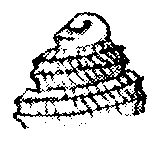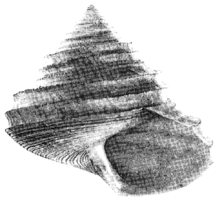Apex
Apex may refer to:
Astronomy
Biology
Places
Organizations

Apex (headdress)
The apex was a cap worn by the flamines and Salii at Rome. The essential part of the apex, to which alone the name properly belonged, was a pointed piece of olive-wood, the base of which was surrounded with a lock of wool. This was worn on the top of the head, and was held there either by fillets only, or, as was more commonly the case, was also fastened by means of two strings or bands, which were called apicula (Festus, s.v.), or offendices (Festus, s.v.), though the latter word is also interpreted to mean a kind of button, by which the strings were fastened under the chin (cf. Serv. ad Virg. Aen. ii.683, viii.664, x.270).
The flamines were forbidden by law to go into public, or even into the open air without the apex (Gellius x.15), and hence we find the expression of alicui apicem dialem imponere used as equivalent to the appointment of a Flamen Dialis (Livy vi.41). Sulpicius was deprived of the priesthood, only because the apex fell from his head whilst he was sacrificing (Valerius Maximus i.1 §5).

Apex (mollusc)
In anatomy, an apex (adjectival form: apical) is part of the shell of a mollusk. The apex is the pointed tip (the oldest part) of the shell of a gastropod, scaphopod, or cephalopod.
Gastropods
The word "apex" is most often used to mean the tip of the spire of the shell of a gastropod. The apex is the first-formed, and therefore the oldest, part of the shell.
To be more precise, the apex would usually be where the tip of the embryonic shell or protoconch is situated, if that is still present in the adult shell (often it is lost or eroded away).
Coiled gastropod shells
The phrase apical whorls, or protoconch, means the whorls that constitute the embryonic shell at the apex of the shell, especially when this is clearly distinguishable from the later whorls of the shell, otherwise known as the teleoconch.
Comparison of the apical part and the whole shell of Otukaia kiheiziebisu:


Limpet-like gastropod shells
Where this feature is present, the space under the apex of a patellate or patelliform (limpet-like) gastropod shell is called the apical cavity.
Shock (mechanics)
A mechanical or physical shock is a sudden acceleration caused, for example, by impact, drop, kick, earthquake, or explosion. Shock is a transient physical excitation.
Shock describes matter subject to extreme rates of force wtr to time. Shock is a vector that has units of an acceleration (rate of change of velocity). The unit g (or g) represents multiples of the acceleration of gravity and is conventionally used.
A shock pulse can be characterised by its peak acceleration, the duration, and the shape of the shock pulse (half sine, triangular, trapezoidal, etc.). The Shock response spectrum is a method for further evaluating a mechanical shock.
Shock measurement
Shock measurement is of interest in several fields such as
Acute stress reaction
Acute stress reaction (also called acute stress disorder, psychological shock, mental shock, or simply shock) is a psychological condition arising in response to a terrifying or traumatic event, or witnessing a traumatic event. It should not be confused with the unrelated circulatory condition of shock, or the concept of shock value.
"Acute stress response" was first described by Walter Cannon in the 1920s as a theory that animals react to threats with a general discharge of the sympathetic nervous system. The response was later recognized as the first stage of a general adaptation syndrome that regulates stress responses among vertebrates and other organisms.
Signs and symptoms
Common symptoms that sufferers of acute stress disorder experience are: numbing; emotional detachment; muteness; derealization; depersonalization; psychogenic amnesia; continued re-experiencing of the event via thoughts, dreams, and flashbacks; and avoidance of any stimulation that reminds them of the event. During this time, they must have symptoms of anxiety, and significant impairment in at least one essential area of functioning. Symptoms last for a minimum of 2 days, and a maximum of 4 weeks, and occur within 4 weeks of the event.
Shock (journal)
Shock: Injury, Inflammation, and Sepsis: Laboratory and Clinical Approaches (ISSN:1073-2322) is the official journal of the Shock Society, the European Shock Society, the Indonesian Shock Society, the International Federation of Shock Societies, and the Official and International Journal of the Japan Shock Society. The journal publishes scholarly research reports on basic and clinical studies of shock, trauma, sepsis, inflammation, ischemia, and related pathobiological states, with particular emphasis on the biologic mechanisms that determine the response to such injury. This scholarly journal has both print and online version. The journal has an impact factor of 3.203 and publishes 12 issues per year.
References
External links
Podcasts:

Shock Out
by: Danny ByrdIs this real?
Is this real or make believe?
Is this real?
Is this real or make believe?
Is this real? (x3)
SHOCKOUT!
Is this real or make believe?
Those were the days i remember
Remember
Remember
SHOCKOUT!
Those were the days i remember
Remember
Remember
I can't believe it's real
Is this real?
Is this real?
Is this real of make believe
Is this real?
Is this real of make believe
Is this real? (x3)
Those were the days i remember
Remember
Remember
SHOCKOUT!
I can't believe it's real (x2)
Those were the days i remember
Remember
Remember
